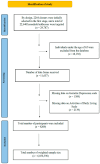Epidemiological Assessment of Depression, Activities of Daily Living and Associated Factors in Elderly Individuals Aged 65 Years and Older: Evidence from a Population-Based Study
- PMID: 40283685
- PMCID: PMC12028177
- DOI: 10.3390/jcm14082853
Epidemiological Assessment of Depression, Activities of Daily Living and Associated Factors in Elderly Individuals Aged 65 Years and Older: Evidence from a Population-Based Study
Abstract
Background: It is a well-established fact that late-life depression represents a significant public health issue, particularly in low- and middle-income countries experiencing rapid demographic aging. Although its clinical and societal impacts are well-recognized, data on the interplay between depressive symptoms and functional status in older populations remain limited for Türkiye. This study aimed to estimate the prevalence of depression among individuals aged 65 years or older, examine its associations with instrumental and basic activities of daily living, and identify key sociodemographic and behavioral correlates. Methods: In this study, data obtained from a population-based survey in 2264 clusters by the Turkish Statistical Institute (TUIK) were used, and weighted data were yielded from 6,036,396 adults aged 65 and over. Depression was measured using the Geriatric Depression Scale (GDS), categorizing participants as "not depressed", "mildly depressed", or "severely depressed". Functional status was evaluated using the Lawton-Brody Instrumental Activities of Daily Living (IADL) Scale and the Katz Activities of Daily Living (ADL) Scale. Logistic regression models, adjusted for age and body mass index (BMI), were used to determine the associations of depression with functional impairment and various covariates, including gender, education, marital status, chronic disease, physical activity, smoking, and alcohol use. Results: Overall, the prevalence of depression in this cohort was 49.9% [95% CI = 48.7-51%], with 36.0% [95% CI = 34.8-37.0%] classified as mild and 13.9% [95% CI = 13.1-14.7%] as severe depression. IADL and ADL scores were negatively correlated with GDS scores (r = -0.416 and r = -0.321, respectively; p < 0.001). In logistic models, lower IADL scores were linked to higher odds of mild (OR = 0.797, 95% CI = [0.796-0.798], p < 0.001) and severe depression (OR = 0.689, 95% CI = [0.688-0.690], p < 0.001). Being semi-dependent or dependent in ADL further escalated depression risk. Female gender, lower education, single/divorced status, chronic disease, and inactivity also emerged as strong predictors. Conclusions: The findings of this study suggest that depression is highly prevalent among older adults in Türkiye, with functional impairment, unfavorable health behaviors, and sociodemographic vulnerabilities heightening risk. Integrating depression screening into geriatric care-alongside interventions to maintain functional independence-may help mitigate the burden of late-life depression in similar contexts.
Keywords: activities of daily living; late-life depression; older adults; population-based; public health.
Conflict of interest statement
The authors declare no conflicts of interest.
Figures


Similar articles
-
Trends over time in the deficit of (instrumental) activities of daily living in the Austrian population aged 65 years and older : Results from the Austrian Health Interview Survey series.Wien Klin Wochenschr. 2024 Sep;136(17-18):488-496. doi: 10.1007/s00508-024-02388-4. Epub 2024 Jun 18. Wien Klin Wochenschr. 2024. PMID: 38890264 Free PMC article.
-
Factors associated with ADL/IADL disability in community dwelling older adults in the Irish longitudinal study on ageing (TILDA).Disabil Rehabil. 2017 Apr;39(8):809-816. doi: 10.3109/09638288.2016.1161848. Epub 2016 Apr 4. Disabil Rehabil. 2017. PMID: 27045728
-
Predictors and consequences of visual trajectories in Chinese older population: A growth mixture model.J Glob Health. 2024 May 31;14:04080. doi: 10.7189/jogh.14.04080. J Glob Health. 2024. PMID: 38817127 Free PMC article.
-
Risk factors of poor sleep quality in older adults: an analysis based on comprehensive geriatric assessment.Curr Med Res Opin. 2023 May;39(5):701-706. doi: 10.1080/03007995.2023.2192124. Epub 2023 Mar 31. Curr Med Res Opin. 2023. PMID: 36927301
-
Daily Living Subjective Cognitive Decline Indicators in Older Adults with Depressive Symptoms: A Scoping Review and Categorization Using Classification of Functioning, Disability, and Health (ICF).Healthcare (Basel). 2022 Aug 10;10(8):1508. doi: 10.3390/healthcare10081508. Healthcare (Basel). 2022. PMID: 36011165 Free PMC article.
Cited by
-
Prevalence of non-communicable diseases and duration of breastfeeding in children under 14 years of age: a nationwide community-based cross-sectional study.Eur J Pediatr. 2025 Jul 23;184(8):496. doi: 10.1007/s00431-025-06346-8. Eur J Pediatr. 2025. PMID: 40699346
-
The association of cardiometabolic multimorbidity with depression and length of hospitalization: a population-based cross-sectional study among adults in Turkey.BMC Public Health. 2025 May 31;25(1):2009. doi: 10.1186/s12889-025-23306-x. BMC Public Health. 2025. PMID: 40450317 Free PMC article.
-
Prevalence of Alzheimer's Disease and Cardiometabolic Multimorbidity in Older Adults Aged 60 and above in a Large-Scale Representative Sample in Türkiye: A Nationwide Population-Based Cross-Sectional Study.J Epidemiol Glob Health. 2025 Jun 16;15(1):86. doi: 10.1007/s44197-025-00435-5. J Epidemiol Glob Health. 2025. PMID: 40522427 Free PMC article.
-
Incidence rate and related factors of depression in older adult patients with somatization symptoms.Front Public Health. 2025 Jul 29;13:1644429. doi: 10.3389/fpubh.2025.1644429. eCollection 2025. Front Public Health. 2025. PMID: 40800024 Free PMC article.
-
Prevalence of self-reported hearing loss and its association with depression in individuals aged 15 years and above in a large-scale representative sample: evidence from a nationwide population-based cross-sectional study.Eur Arch Otorhinolaryngol. 2025 Aug;282(8):4075-4088. doi: 10.1007/s00405-025-09562-y. Epub 2025 Jul 12. Eur Arch Otorhinolaryngol. 2025. PMID: 40652132
References
-
- Stein D.J., Szatmari P., Gaebel W., Berk M., Vieta E., Maj M., de Vries Y.A., Roest A.M., de Jonge P., Maercker A., et al. Mental, behavioral and neurodevelopmental disorders in the ICD-11: An international perspective on key changes and controversies. BMC Med. 2020;18:21. doi: 10.1186/s12916-020-1495-2. - DOI - PMC - PubMed
-
- Depressive Disorder (Depression) [(accessed on 25 March 2025)]. Available online: https://www.who.int/news-room/fact-sheets/detail/depression.
-
- Chauhan P., Kokiwar P.R., Shridevi K., Katkuri S. A study on prevalence and correlates of depression among elderly population of rural South India. Int. J. Community Med. Public Health. 2016;3:236–239. doi: 10.18203/2394-6040.ijcmph20151569. - DOI
LinkOut - more resources
Full Text Sources

